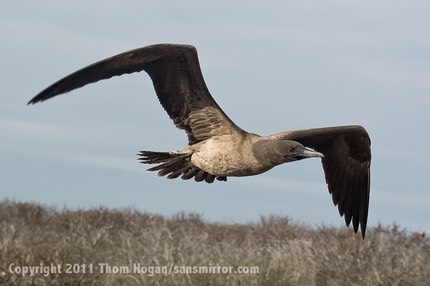
Nikon V1, 30-110mm, 1/1600, ISO 400
For the past two weeks I toured the Galapagos, mostly with mirrorless cameras that I was testing (I did bring one DSLR). One thing that's easy to test in the Enchanted Islands is birds in flight: basically a fairly worst case continuous focusing challenge, and available pretty much on demand at most of the visitation sites. In the Galapagos in many cases the birds are flying extremely close in to you: it isn't just tough to focus on them, it's tough to just follow them with the camera.
In particular, I was interested in the difference between performance of the Panasonic G3, the latest Olympus Pens (with claimed "world's fastest AF"), and the Nikon V1. Simple answer: it wasn't even a contest, as the V1 won hands down every time. Indeed, for many bird passes it was the only camera that got a critically sharp bird (and often more than one or two frames of them). More often than not the Panasonic got no sharp birds in close in the passes by the swiftest birds. When it did manage a sharp bird it was usually much further away from me and it was "one and done." The Olympus E-PL3 and E-P3 performed slightly better, but not by a lot. (Lenses in use: mostly Nikon 30-110mm, Panasonic 45-175mm X.)
For example, I spent a couple of hours on the bird-filled cliffs at Tower Island just trying to track flying boobies (see photo, above), pelicans, frigate birds, and more. This was a very tough test, as most of the action was crossing within feet of me as the birds headed out to sea or back to the nests. Even my D7000 struggled with some tracking. In many cases birds passed between me and my fellow travelers who were standing nearby. Just keeping the cameras centered on the birds whizzing by like this is a chore with the EVF-based cameras and telephoto lenses, but nearly impossible holding an LCD-only camera in front of you.
Overall, I was very impressed with the Nikon V1, and by the end of the trip it was the only mirrorless camera I wanted to shoot birds in flight with. The V1's focus performance comes incredibly close to higher-end DSLR levels once you get the right settings for a subject (a little trickier than on the Nikon DSLRs, admittedly).
I wasn't so impressed by the Panasonic G3, with which I eventually gave up on trying to get the shots I wanted of birds in flight. Ditto the Olympii. This just goes to show that phase detect autofocus does indeed have its advantages.
That said, there were other things that the G3, E-PL3, and E-P3 do extremely well at. Shooting the marine iguanas, tortoises, and other slow moving animals worked well enough. The Olympus cameras got the coloration of the marine iguanas just right, for instance. The Panasonic's swivel LCD came in handy as some giant tortoises came almost literally over me to get to a mud pond, and getting 16mp on some of the landscape scenes is highly welcome (compared to the V1's 10mp especially). It's just that they're not great follow focus cameras, especially on things that are moving fast and close by. More to come in my reviews.
Followup comment: a number of people want to know "so what's the optimal BIF setting?" I don't know for sure yet, otherwise I would have reported it. That's why I continue to do testing. Also, because of the complexity of focus systems versus subjects, it's usually not a short answer, which is why I usually cover it in my books, not in articles. As I've written many times, there is no "magic setting" that solves all problems. You have to adapt to what's happening in front of you, and that gets complex very quickly. That is one reason why the menu-buried settings in the Nikon 1 system are an issue for a serious shooter, by the way: it's difficult to change some things quickly in reaction to what's happening. Moreover, there are different shooting styles that are involved. But I'll add another line just to be clearer: even with sub-optimal AF settings, the Nikon V1 beat the G3 hands down, every time.


